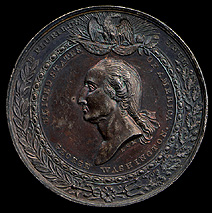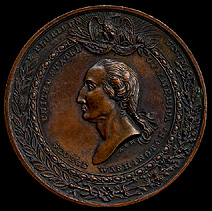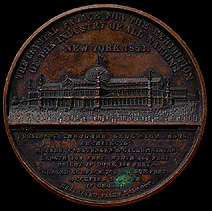Washington Medals 1850-1859
The Crystal Palace Medal of 1853
obverse |
|
reverse |
| |||
Baker 361 NYC Crystal Palace Medal A. C. Morin and A. Paquet Philadelphia
Obverse: [outer rim] E PLURIBIS UNUM [inner legend] UNITED STATES OF AMERICA [below] GEORGE WASHINGTON . [engraver's initials below bust] A C M
Reverse: [above] THE CRYSTAL PALACE FOR THE EXHIBITION/ OF THE INDUSTRY OF ALL NATIONS . / NEW YORK, 1853 . [just below the walkway] PAQUET PHILA [on the lower portion] PRESIDENT : THEODORE SEDGWICK, ESQR : / ARCHITECTS : / MESSRS : C
ARSTENSEN & GILDEMEISTER, / LENGTH 365 FEET, WIDTH 365 FEET, / HEIGHT OF DOME 148 FEET. / GLAZED SURFACE 206,OOO SUP FEET, / OCCUPIES 5 ACRES/ OF GROUND . / ESTIMATED VALUE $450,000 .
Silver Weight: 894.0 g (57.93 grams) Diameter: 51.7 mm Reverse die alignment: 360°
Comments: New York City's Crystal Palace opened as the sight of 1853 exposition. This spectacular exhibition hall was one of several modeled after the remarkable iron and glass Crystal Palace exhibition hall constructed in London as part of the Great Exhibition of 1851. Whereas the London palace survived until 1936, New York City's Crystal Palace burned to the ground in October of 1859. Similar halls were construced as the centerpiece for exhibitions in Cork (1852), Dublin (1853), Munich (1854) and Paris (1855).
The medal commemorating the opening of the New York City palace has an obverse designed by Anthony C. Morin with a bust left portrait of Washington surrounded with an elaborate wreath border design symbolizing peace and war. Below is a rosette with a caduceus to the left from which comes an olive branch, on the right side of the rosette is a trident from which comes oak leaves and acorns. The caduceus represents healing and the olive branch is a traditional symbol of peace; the trident was a weapon of gladiatorial combats representing war and the oak leaves and acorns represent the military (they are is used in various military decorations as the Oak Leaf Cluster). Above Washington is a american eagle with rays perched on a flag having arrows to the left and olive leaves to the right. The reverse, designed by Anthony Paquet, has a highly detailed three dimensional view of the palace with the walkway jutting out so that it creates a ridge on the surface of the coin.
Provenance: Part of an anonymous donation consisting of 1100 tokens and medals covering the Nineteenth century, primarily up through the Civil War era.
Reference: .
obverse |
|
reverse |
| |||
Baker 361A NYC Crystal Palace Medal A. C. Morin and A. Paquet Philadelphia
Obverse: [outer rim] E PLURIBIS UNUM [inner legend] UNITED STATES OF AMERICA [below] GEORGE WASHINGTON . [engraver's initials below bust] A C M
Reverse: [above] THE CRYSTAL PALACE FOR THE EXHIBITION/ OF THE INDUSTRY OF ALL NATIONS . / NEW YORK, 1853 . [just below the walkway] PAQUET PHILA [on the lower portion] PRESIDENT : THEODORE SEDGWICK, ESQR : / ARCHITECTS : / MESSRS : C
ARSTENSEN & GILDEMEISTER, / LENGTH 365 FEET, WIDTH 365 FEET, / HEIGHT OF DOME 148 FEET. / GLAZED SURFACE 206,OOO SUP FEET, / OCCUPIES 5 ACRES/ OF GROUND . / ESTIMATED VALUE $450,000 .
Bronze Weight: 1202.7 g (77.93 grams) Diameter: 51.8 mm Reverse die alignment: 360°
Comments: New York City's Crystal Palace opened as the sight of 1853 exposition. This spectacular exhibition hall was one of several modeled after the remarkable iron and glass Crystal Palace exhibition hall constructed in London as part of the Great Exhibition of 1851. Whereas the London palace survived until 1936, New York City's Crystal Palace burned to the ground in October of 1859. Similar halls were construced as the centerpiece for exhibitions in Cork (1852), Dublin (1853), Munich (1854) and Paris (1855).
The medal commemorating the opening of the New York City palace has an obverse designed by Anthony C. Morin with a bust left portrait of Washington surrounded with an elaborate wreath border design symbolizing peace and war. Below is a rosette with a caduceus to the left from which comes an olive branch, on the right side of the rosette is a trident from which comes oak leaves and acorns. The caduceus represents healing and the olive branch is a traditional symbol of peace; the trident was a weapon of gladiatorial combats representing war and the oak leaves and acorns represent the military (they are is used in various military decorations as the Oak Leaf Cluster). Above Washington is a american eagle with rays perched on a flag having arrows to the left and olive leaves to the right. The reverse, designed by Anthony Paquet, has a highly detailed three dimensional view of the palace with the walkway jutting out so that it creates a ridge on the surface of the coin.
Provenance: Part of an anonymous donation consisting of 1100 tokens and medals covering the Nineteenth century, primarily up through the Civil War era.
Reference: .
|
|
|
|
| 1840-49 | Section Contents | 1850-59b1 |



